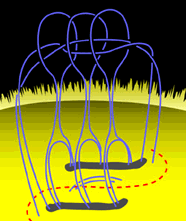
SIGMOIDAL SIGNAL. Animation shows a sigmoid recorded by the Yohkoh Soft X-Ray Telescope on June 8, 1998 (long delay) and the sigmoid with a cusp, indicating that an eruption has taken place, made a day later.


SIGMOIDAL SIGNAL. Animation shows a sigmoid recorded by the Yohkoh Soft X-Ray Telescope on June 8, 1998 (long delay) and the sigmoid with a cusp, indicating that an eruption has taken place, made a day later. |
Several times each day, the sun hurls out violent bursts of hot, electrically charged gas. When they are aimed the right way, these vast explosions, called Coronal Mass Ejections (CMEs), send up to 11 billion tons of ionized gas speeding toward earth. When it arrives four days later, this solar storm cloud can knock out communications, damage satellites and cause power failures. There is no way to stop them, but now scientists believe that they can at least predict them so that valuable systems can be protected.
In a paper published in the March 15 issue of Geophysical Research Letters, Richard Canfield and David McKenzie of Montana State University-Bozeman, and Hugh Hudson of the Solar Physics Research Corp. in Tucson, report that the appearance of S-shaped patterns on the sun, called sigmoids, mark the site of an impending eruption in the next few days. "The S-shaped regions are the dangerous ones," says Canfield, a research professor of physics. "As soon as we can recognize an S-shaped region, we know that it is more likely to erupt. Other common structures look like a butterfly, quite symmetric, and these rarely erupt."The sigmoid structures are likely the result of twisted magnetic fields that reveal themselves in the filaments and prominences that rise and fall from the sun's surface. In a CME, magnetic field lines that should slide past each other twist and reconnect, forming a loop filled with ionized gas. At a critical point, the magnetic field snaps back, thrusting a blob of gas--still constrained by its own magnetic field--into space at speeds of up to 3 million kilometers an hour.
 |
The first observation that "S" marks the spot of an eruption was made by Hudson and Alphonse Sterling of Computational Physics Inc. when they were working at the Institute of Space and Astronautical Science (ISAS) in Japan. Analyzing x-ray images of the sun captured by Japan's Yohkoh satellite, they noticed a relationship between a sigmoid shape before a CME, and an arch-shape--or cusp--afterwards.
That finding prompted Canfield to see if there was a statistical correlation between the sigmoid shape and subsequent eruptions. The researchers compiled two years' worth of Yohkoh's 50 daily X-ray images into movies that they analyzed on TV--and they found a distinct match: sigmoidal regions account for 65 percent of the observed eruptions. The findings also showed that larger sunspot areas--which appear as dark areas on the sun's surface--were more likely to erupt than smaller ones.
The next step is to turn those correlations into an accurate predictive tool. "We need to get past simple classifications such as 'Is it sigmoidal or not, is the sun spot big or small' and get to quantitative measurements that answer 'how twisted are the magnetic fields, how big is the spot'," says Canfield.
Those answers may come from a forthcoming National Aeronautics and Space Administration satellite called STEREO, for Solar Terrestrial Relations Observatory. It's mission will be to record three dimensional images of CMEs and the structures around them. It probably won't be long until space weather forecasts issued by the National Oceanic and Atmospheric Administration will include warnings of impending CMEs. The agency is already planning to launch a Solar X-Ray Imager, similar to that on Yohkoh, next year.By Alan Hall
RELATED LINKS:
Movie of an S-shaped region that exploded October 24, 1994
Coronal Ejections Predictions Page from Montana State University
Yohkoh home page
CME information from Goddard Space Flight Center
SpaceWeather.com forecasts solar activity
The Sun--an overview from Views of the Solar System